The Garden Helper's Plant of the Day ArchiveThe Plants of the Day for July 2011Below you will find an index of all the plants, flowers and trees that have been profiled as aPlant of the Day at The Garden Helper during July of 2011 |
More Plants and FlowersOctober 2010November 2010 January 2011 February 2011 March 2011 April 2011 May 2011 June 2011 August 2011 The Plant of the Week 2011 The Plant of the Week 2012 |
July 1, 2011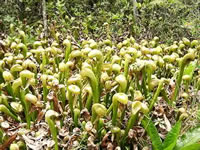 California Pitcher Plant Darlingtonia californica California Pitcher plants, aka: Cobra Lilies are carnivorous plants that lure their insect prey with a sweet nectar which is inside the leaf opening under it's hood. Once inside, the insect becomes confused by the many transparent areas of the upper leaf surfaces, which appear to be exits.... Hardy in zones 7-10 |
July 2, 2011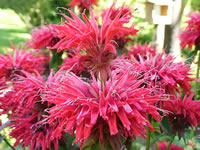 Bee Balm Monarda didyma Monarda plants grow from two to four feet tall depending on the variety, and will fit well into your herb, Hummingbird, or Butterfly Garden. Lower growing varieties of Bee Balm can be used for a perennial border planting. Be sure to allow for good air circulation. Hardy in USDA zones 4-9. |
July 3, 2011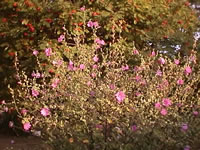 Hollyhock Mallow Malva alcea Hollyhock Mallow plants are multi-stemmed, upright perennials that grow 2-4 feet tall, forming 2 foot clumps. From mid summer until fall, they produce spikes of 2" rose-pink or white flowers that resemble Hollyhocks. Mallow are reliable, easy to care for plants. Hardy in USDA zones 4-8. |
July 4, 2011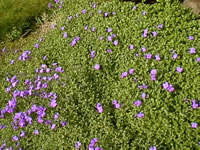 False Rock Cress Aubrieta deltoidea False Rock Cress is a vigorous growing, mat forming, semi-evergreen ground cover that is excellent as a rock garden plant, for planting between stepping stones, along pathways, or in the crevices of stone walls. Tolerant of a wide range of conditions, and will reward you with a long lasting cover of delicate flowers in early Spring.. Hardy in USDA zones 4-9 |
|
|
||||
July 5, 2011 Blanket Flower Gaillardia grandiflora The Blanket Flower is a perennial member of the sunflower family. The bright, daisy like flower heads may reach up to 4 inches across and may be single or double flowered, depending on the variety. These perennials generally grow from two to three feet tall, but there are also many new hybrid strains which only attain a height of a foot. Hardy in USDA zones 4-10 |
July 6, 2011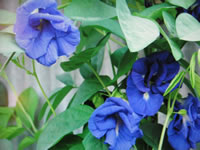 Butterfly Pea Clitoria ternatea The Butterfly Pea is a fairly common, fast growing, climbing, tender perennial species that produces two inch, pinkish blue flowers in mid to late Summer. They provide quick covers for lattice, trellis, arbors and chain-link fences,, and are a favorite food source for butterflies. Butterfly Pea seed pods are edible and tasty. Hardy in USDA zones 10-11 |
July 7, 2011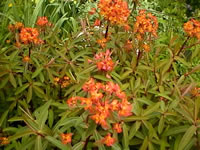 Butterfly Weed Asclepias tuberosa Butterfly Weed is a drought resistant, perennial wildflower that is native to much of North America. The flat clusters of fragrant orange flowers form on top of 2'-3' stems in July and August. The slender leaves are 2"-3" long and fuzzy. Butterfly Weed is an important food source for butterflies. Hardy in USDA zones 3-9 |
July 8, 2011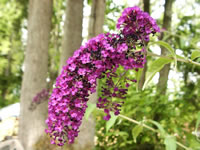 Butterfly Bush Buddleia davidii The Butterfly Bush is a fast growing, drought tolerant, deciduous shrub that will produce a multitude of clustering, arching spikes of tiny, fragrant flowers in late summer on branches that will sometimes reach 15' tall. Butterfly Bushes will grow in almost any soil if they are planted in full sun or light shade. Hardy in USDA zones 5-9 |
July 9, 2011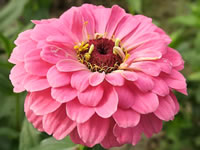 Zinnia Zinnia elegans Zinnias are very easy to grow annual plants that produce an abundance of bright and often multi colored, 1-7", single or double flowers from early summer until the first frost. There are hundreds of different Zinnia hybrids on the market, and more are being added each year. Annual Plant |
|
|
||||
July 10, 2011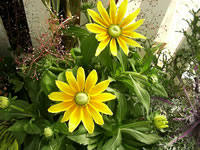 Treasure Flower Gazania hybrids The Treasure Flower's daisy-like flowers are 2-5 inches in diameter, growing atop 6-12 inch stalks. Gazania flowers are brightly bi-colored combinations of orange, pink, red, white, cream, or yellow. The foliage is somewhat grasslike, but narrow at the base and widening toward the tip. Annual Plant |
July 11, 2011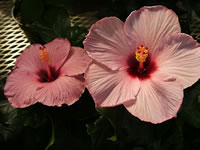 Rose Mallow Hibiscus moscheutos Rose Mallow is a fast growing, deciduous, perennial shrub that forms three foot clumps and can grow four to eight feet tall in a single season. From mid summer until mid fall, they produce huge, 5"-12" flowers with deep red or burgundy centers and very distinctive stamens. Hardy in USDA zones 5-10. |
July 12, 2011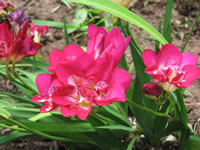 Freesia Freesia x hybrida Freesias are tender, brightly flowered, easy to care for bulbs that can be grown in the garden, in planters, or as a house plant in a sunny, cool room. Their fragrant, 2" flowers open over a long blooming period, in sequence along 12"-18", arching, wirey stems. Hardy in USDA zones 9-10. |
July 13, 2011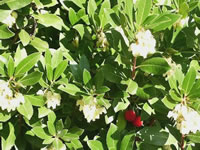 Strawberry Tree Arbutus unedo The Strawberry Tree is an easy to care for, evergreen shrub that will typically grow from 10-15 ft. tall and wide, but are capable of reaching up to 30 feet. The gnarled and twisted trunks and branches are covered with reddish brown bark that contrasts nicely with the glossy green foliage. Hardy in USDA zones 7-10. |
July 14, 2011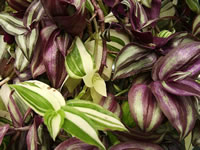 Wandering Jew Tradescantia zebrina The Wandering Jew, also known as a Silver Inch Plant, is a frost tender, creeping perennial. There are several hybrid varieties of Wandering Jew that have foliage colors in combinations of white, pink, purple, yellow, silver or green stripes. In most areas Wandering Jew are grown as house plants Hardy in USDA zones 9-12. |
July 15, 2011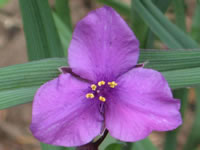 Spiderwort Tradescantia x andersoniana Spiderworts are clump forming perennials that from early through mid-summer continuously produce butterfly attracting, 1"-1½", three petaled, triangular, flowers on stems that rise slightly above the narrow, strap-like foliage. Hardy in zones 4-9 |
July 16, 2011 Dahlias With a blast of different colors, shapes and sizes, Dahlias bring life and beauty back to your landscape in late summer and into the fall months. Dahlias make excellent cut flowers that typically last about a week in the house. Hardy in zones 7-11 |
July 17, 2011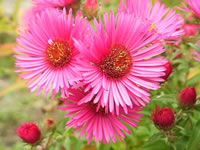 New England Aster Aster novae-angliae When your garden colors begin to fade in the fall, and you just aren't ready for plain green landscape, plant an Aster! Asters produce large clusters of delicate daisy-like flowers in white, purple, lavender, pink or red from August through October. Hardy in zones 4-9 |
July 18, 2011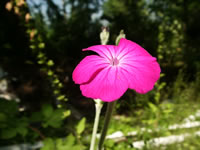 Rose Campion Lychnis coronaria The botanical name, Lychnis, is from the Greek word for lamp, referring to the flame colored flowers of some species and the fact that the felt-like leaves were once used for lamp wicks. They produce a profusion of vividly colored flowers in the summer. Hardy in zones 4-10 |
July 19, 2011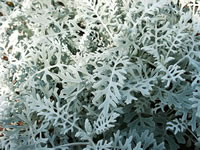 Dusty Miller Senecio cineraria Dusty Miller are compact, mound forming, evergreen perennial plants that are typically grown as annuals in cooler regions. The deeply cut, silvery-gray foliage of these 12" plants make them perfect for borders or as companion plantings for brightly colored annual flowers. Hardy in USDA zones 8-11. |
July 20, 2011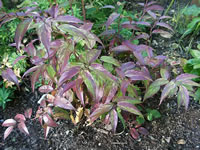 Mountain Doghobble Leucothoe fontanesiana Depending on where you live it might be called a Rainbow Leucothoe, a Scarlet Fetterbush, Drooping Leucothoe, or my favorite plant name of all... the Mountain Doghobble! The glossy foliage is marbled in bright shades of green, pink, cream, burgundy and bronze. Hardy in zones 5-8 |
July 21, 2011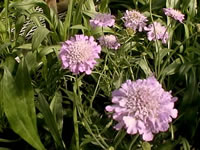 Pincushion Flower Scabiosa columbaria The Pincushion Flower is a long blooming, clump forming perennial with grayish-green, 2"-6", lance-shaped basal leaves and smaller, deeply dissected stem leaves. If deadheaded diligently, they will bloom from early summer until the first frost of fall. Attracts butterflies. Hardy in zones 4-8 |
July 22, 2011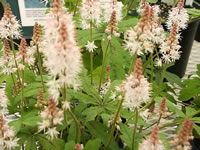 Foamflower Tiarella cordifolia Foamflowers are easy to grow, perennial wildflowers that form 6"-10" tall clumps of heart shaped leaves. They quickly spread to form nice two foot patches of this shade loving groundcover. Tiarella produce whispy plumes of creamy white or pale pink, ¼" star shaped flowers. Hardy in zones 3-8 |
July 23, 2011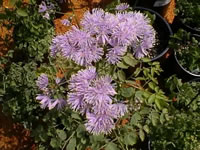 Columbine Meadow Rue Thalictrum aquilegifolium Meadow Rue plants are mound forming perennials that will grow to about three feet tall and spread to about 18". They are known for their lacy, bluish green foliage that closely resembles that of the Columbine plant. A great addition to any Butterfly garden Hardy in zones 4-8 |
July 24, 2011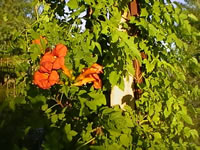 Trumpet Creeper Campsis radicans Trumpet Creeper are deciduous, clinging vines with dark green, compound leaves that are capable of quickly climbing to heights of 30 feet. Throughout the summer they produce terminal clusters of 6-12, bright scarlet orange, 3" trumpet shaped flowers. A Hummingbird Favorite! Hardy in zones 4-10 |
July 25, 2011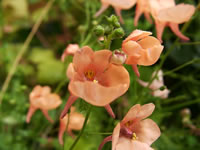 Twinspur Diascia barberae Twinspurs are a vigorous growing, tender perennials that are closely related to the Snapdragon. They have small, heart shaped foliage and grow from 6"-12" tall, forming 8"-20" clumps. From late spring until early fall, they produce bright pink or salmon colored, 1/2"-3/4" flowers. Hardy in zones 8-10 |
July 26, 2011 Daylily Hemerocallis Daylilies produce an abundance of flowers in many colors and shades, which open over a long period of time. They are useful in the perennial flower border, as a garden centerpiece, or any corner of the garden which needs to be brightened up. Hardy in USDA zones 3-9 |
July 27, 2011 American Honeysuckle Lonicera americana Honeysuckle vines are easy to grow, vigorous, heat-tolerant, and nearly indestructible. The flashy and fragrant flowers will attract hummingbirds and butterflies all summer long. The resulting fruit of the Honeysuckle flower will provide a fall treat for your local songbirds as well. Hardy in USDA zones 5-9 |
July 28, 2011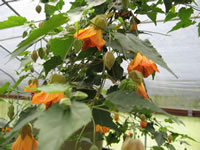 Flowering Maple Abutilon hybridum The Flowering Maple can be grown outdoors in warmer regions, but it is most often grown as a house plant. The flowers differ with each species, but generally resemble a cross between a Hibiscus and a Hollyhock. There are variegated forms with white or yellow mottling. Hardy in USDA zones 8-10 |
July 29, 2011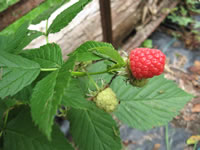 Raspberry Rubus idaeus There are two categories of red raspberries, the common raspberry, which ripens in early to midsummer and the so called ever bearing raspberry. Raspberries are valuable in home gardens because of the fruits fragile and perishable nature which prohibits the shipping of fresh berries. Hardy in USDA zones 4-8 |
July 30, 2011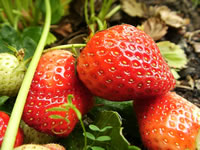 Strawberry Fragraria ananassa Strawberries, are quite easy to grow. They are perennial, winter hardy, and will thrive in full sunshine, as long as the soil is fertile and well drained. Healthy plants will produce an abundance of berries for three to four years, after which they should be replaced. Hardy in USDA zones 5-10 |
July 31, 2011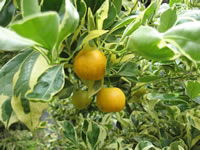 Dwarf Citrus Citrus mitis Dwarf Citrus such as oranges, lemons, and limes are living conversation pieces. Their shiny foliage, bright fruits, and fragrant blossoms provide year-round enjoyment. Dwarf Citrus trees are well adapted for growing in containers and as house plants. Hardy in USDA zones 9-11 |
|||
Search The Garden Helper: